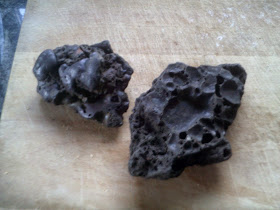My lamp looks like this:
I wondered whether it was an interference effect like Lloyd's mirror but the angles were all wrong. But it occurred to me that it might be that I was detecting the ac flicker of a fluorescent tube. Alternating current would mean it would be flashing 50 times a second. So why does that show up as line on the screen? To understand my theory, look at this photograph that I took from the coach on the Berlin trip
The odd angle on the back of the lorry suggests to me that the CCD on the back of the camera loads in lines from top to bottom. Hence the lorry has moved forward by the time the bottom of the picture is taken. If that's the case, then during an exposure, the light would be on for some lines and off for other lines, giving me my picture. 6 lines would give an exposure time of 0.12 seconds. However, the lines stay horizontal when I turn the camera through 90 degrees. Would the camera read the lines the other way if I turned the camera? Probably not so more thought necessary.







.JPG)








































